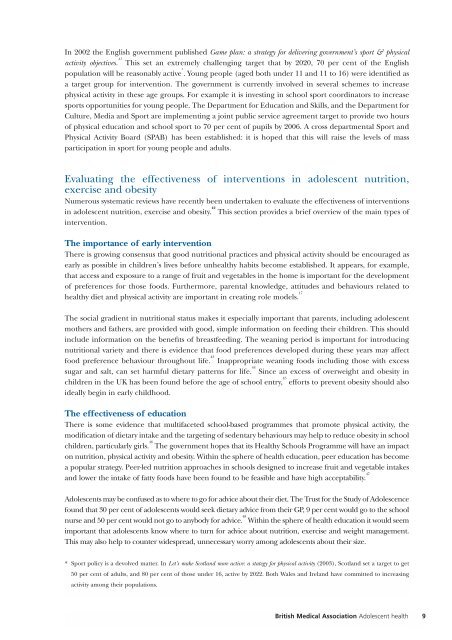Alcohol misuse: tackling the UK epidemic - London
Alcohol misuse: tackling the UK epidemic - London
Alcohol misuse: tackling the UK epidemic - London
You also want an ePaper? Increase the reach of your titles
YUMPU automatically turns print PDFs into web optimized ePapers that Google loves.
In 2002 <strong>the</strong> English government published Game plan: a strategy for delivering government’s sport & physical<br />
activity objectives. 41<br />
This set an extremely challenging target that by 2020, 70 per cent of <strong>the</strong> English<br />
population will be reasonably active *<br />
. Young people (aged both under 11 and 11 to 16) were identified as<br />
a target group for intervention. The government is currently involved in several schemes to increase<br />
physical activity in <strong>the</strong>se age groups. For example it is investing in school sport coordinators to increase<br />
sports opportunities for young people. The Department for Education and Skills, and <strong>the</strong> Department for<br />
Culture, Media and Sport are implementing a joint public service agreement target to provide two hours<br />
of physical education and school sport to 70 per cent of pupils by 2006. A cross departmental Sport and<br />
Physical Activity Board (SPAB) has been established: it is hoped that this will raise <strong>the</strong> levels of mass<br />
participation in sport for young people and adults.<br />
Evaluating <strong>the</strong> effectiveness of interventions in adolescent nutrition,<br />
exercise and obesity<br />
Numerous systematic reviews have recently been undertaken to evaluate <strong>the</strong> effectiveness of interventions<br />
in adolescent nutrition, exercise and obesity. 42<br />
This section provides a brief overview of <strong>the</strong> main types of<br />
intervention.<br />
The importance of early intervention<br />
There is growing consensus that good nutritional practices and physical activity should be encouraged as<br />
early as possible in children’s lives before unhealthy habits become established. It appears, for example,<br />
that access and exposure to a range of fruit and vegetables in <strong>the</strong> home is important for <strong>the</strong> development<br />
of preferences for those foods. Fur<strong>the</strong>rmore, parental knowledge, attitudes and behaviours related to<br />
healthy diet and physical activity are important in creating role models. 17<br />
The social gradient in nutritional status makes it especially important that parents, including adolescent<br />
mo<strong>the</strong>rs and fa<strong>the</strong>rs, are provided with good, simple information on feeding <strong>the</strong>ir children. This should<br />
include information on <strong>the</strong> benefits of breastfeeding. The weaning period is important for introducing<br />
nutritional variety and <strong>the</strong>re is evidence that food preferences developed during <strong>the</strong>se years may affect<br />
food preference behaviour throughout life. 43<br />
Inappropriate weaning foods including those with excess<br />
sugar and salt, can set harmful dietary patterns for life. 44<br />
Since an excess of overweight and obesity in<br />
children in <strong>the</strong> <strong>UK</strong> has been found before <strong>the</strong> age of school entry, 45<br />
efforts to prevent obesity should also<br />
ideally begin in early childhood.<br />
The effectiveness of education<br />
There is some evidence that multifaceted school-based programmes that promote physical activity, <strong>the</strong><br />
modification of dietary intake and <strong>the</strong> targeting of sedentary behaviours may help to reduce obesity in school<br />
children, particularly girls. 46<br />
The government hopes that its Healthy Schools Programme will have an impact<br />
on nutrition, physical activity and obesity. Within <strong>the</strong> sphere of health education, peer education has become<br />
a popular strategy. Peer-led nutrition approaches in schools designed to increase fruit and vegetable intakes<br />
and lower <strong>the</strong> intake of fatty foods have been found to be feasible and have high acceptability. 47<br />
Adolescents may be confused as to where to go for advice about <strong>the</strong>ir diet. The Trust for <strong>the</strong> Study of Adolescence<br />
found that 30 per cent of adolescents would seek dietary advice from <strong>the</strong>ir GP, 9 per cent would go to <strong>the</strong> school<br />
nurse and 50 per cent would not go to anybody for advice. 48<br />
Within <strong>the</strong> sphere of health education it would seem<br />
important that adolescents know where to turn for advice about nutrition, exercise and weight management.<br />
This may also help to counter widespread, unnecessary worry among adolescents about <strong>the</strong>ir size.<br />
* Sport policy is a devolved matter. In Let’s make Scotland more active: a stategy for physical activity (2003), Scotland set a target to get<br />
50 per cent of adults, and 80 per cent of those under 16, active by 2022. Both Wales and Ireland have committed to increasing<br />
activity among <strong>the</strong>ir populations.<br />
British Medical Association Adolescent health 9
















